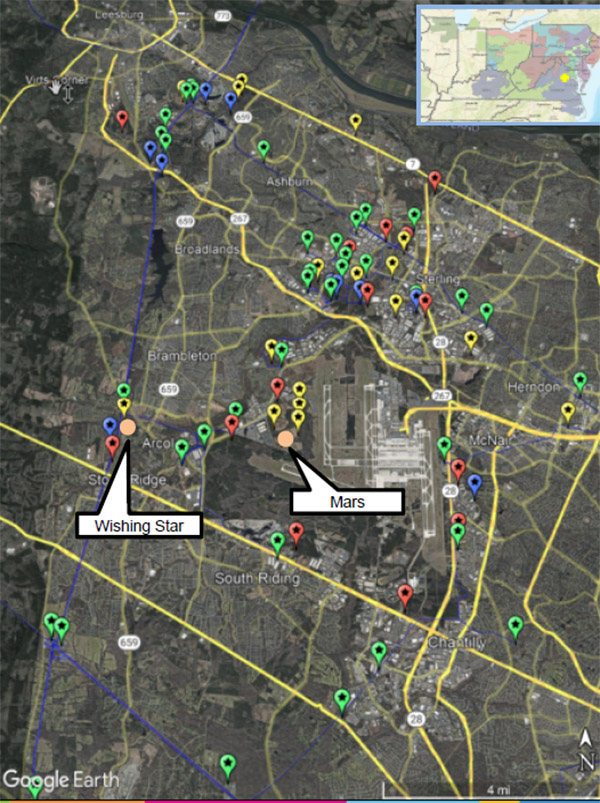VALLEY FORGE, Pa. — Dominion Energy (NYSE:D) plans $603 million in additional transmission spending to serve the unprecedented growth of data centers near Dulles Airport in Virginia, and FirstEnergy (NYSE:FE) is also reporting an explosion of data center demand, PJM officials said Tuesday.
“We’ve seen a lot of data center growth in this particular area, Loudon County,” Ken Seiler, PJM vice president of planning, told the Transmission Expansion Advisory Committee. “Seventy percent of the world’s Internet traffic flows through there. Over the last few months [data center demand has] ramped up tremendously. … We’re trying to a get a handle on what the projected growth rate and if it’s sustainable.
“We’ve never seen anything like this, being so concentrated,” he added. “And we don’t see any evidence it’s going to be stopping anytime soon.”
PJM designated Dominion to construct a $603 million “immediate need” project to address short-term reliability issues through 2025.
 PJM and Dominion are attempting to serve unprecedented growth of data centers near Dulles Airport in Virginia by building new transmission between new Wishing Star and Mars substations. Existing data centers are identified in green; those in design/construction (red); in planning (dark blue) and inquiry stage (yellow). | PJM
PJM and Dominion are attempting to serve unprecedented growth of data centers near Dulles Airport in Virginia by building new transmission between new Wishing Star and Mars substations. Existing data centers are identified in green; those in design/construction (red); in planning (dark blue) and inquiry stage (yellow). | PJMSeiler said PJM is looking for “broader, regional-scale projects” to solve reliability problems beyond 2025, to serve anticipated load growth of more than 10,000 MW over next five years in the Dominion transmission zone and FirstEnergy zone in Northern Virginia and Frederick County, Md.
PJM announced the Dominion immediate need project last month, but provided the first cost data and details at Tuesday’s TEAC meeting. (See PJM Orders Dominion ‘Immediate Need’ Projects to Serve Load Jump in ‘Data Center Alley’.)
The project will include a new Wishing Star substation ($180 million); a new Mars substation ($167 million); 500-kV and 230-kV line extensions ($132 million); Brambleton substation upgrades ($12 million), Loudoun breaker replacements ($5 million); 230-kV Line #2079/Davis Drive upgrades ($15 million) and risk/contingency/escalation costs ($92 million).
The required service date is June 1, 2025.
Dominion is already constructing 11 “supplemental” transmission upgrades estimated at $197 million and two “baseline” transmission upgrades totaling more than $32 million to address load growth in the area, dubbed “Data Center Alley.”
Earlier in the TEAC, Dominion described solutions for 13 supplemental projects totaling $366 million, all but two of them the result of data centers or other “customer service” drivers.
Seiler said PJM and Dominion will be coordinating outages and using demand response and behind-the-meter generation to protect existing loads during construction. “Any and all things are on the table at this point,” Seiler said.
In addition, the PJM planning team will be “assembling late this month to consider what additional options do we have to determine what the long-term regional solution will be,” he added.
Data centers have grown from 30 MW each to 60 MW and “even as high as 90 MW,” said Seiler. Data center campuses have grown from 200 MW to as much as 600 MW each, he said. Seiler said data centers are only providing Dominion two year’s notice or less of when they want to begin operations.
Dominion’s load is growing by 3% per year for 2022-2027, all of it from data centers, while PJM’s load growth has been 0.4% or less annually. (See “Data Center Alley,” Dominion CEO: SCC Order for OSW Performance Guarantee ‘Untenable’.)
Cost Allocation
“It’s a little too soon to tell yet,” Seiler said when asked about cost allocation of the upgrades. “Right now, I don’t have those numbers available.”
But he noted that PJM rules require regional allocations for double-circuit 345-kV lines and above.
“The way our rules are set up today, anything double-circuit 345-kV and above — and you’re talking 500 [kV] here in some cases — will be allocated 50% on a load-ratio share,” he explained in an interview after the meeting. “… Then, the lower voltage stuff is all contained within the Dominion zone, or [based on] the distribution factors and where that power flows — so, whoever benefits from it. So, we have to run [analyses on] all that.”
The supplemental projects described Tuesday will be allocated to Dominion’s zone but also included in the base cases PJM uses to evaluate potential regional solutions Seiler said.



